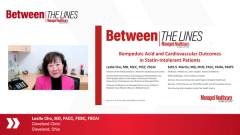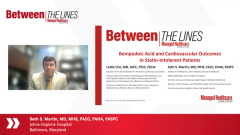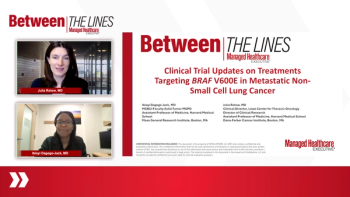
Examining CLEAR Outcomes Trial Structure
Key opinion leaders discuss parameters and limitations of the CLEAR Outcomes clinical trial.
Episodes in this series
Seth S. Martin, M.D., M.H.S., FACC, FAHA, FASPC: As we think about the characteristics of the patients in the trial, because they couldn’t take statin therapy and because the LDL [low-density lipoprotein] had to be above 100 mg/dL at baseline, it was a pretty high LDL as clinical trials go. I believe the average baseline LDL was around 139 mg/dL, which is quite high. Maybe we can walk through some of the other characteristics.
Leslie Cho, M.D., FACC, FESC, FSCAI: That’s very important. Thank you for bringing that up. LDL is very high. In a modern cholesterol trial, these are some of the highest LDLs we’ve seen. If you think about secondary prevention patients, who make up 70% [of the trial participants], these are high LDLs. These patients aren’t getting standard therapy because they can’t take statins. As you and I know, some patients who don’t want to take an injection and don’t want to be on PCSK9. These were patients with an average age of 65. They were very well matched in terms of patient characteristics. But they had a very high LDL. In keeping with that, their CRP level was also high.
Seth S. Martin, M.D., M.H.S., FACC, FAHA, FASPC: Almost half were women, which was something that got a round of applause when this trial was presented by Steve Nissen at the ACC [American College of Cardiology Scientific Session & Expo]. That’s because many trials have not included as many women. It’s a real problem that’s been well recognized. There was well-deserved applause for this being nearly half women.
Leslie Cho, M.D., FACC, FESC, FSCAI: Thank you for mentioning that. We’re very proud of that. The enrollment rate in most cardiovascular trials is 30% women. That’s been the bane of our existence. We’ve written about the underrepresentation of women in cardiovascular trials and how to make it better. This trial had 1 of the highest enrollments of women in the modern era. Seth, what do you think are the limitations of the trial?
Seth S. Martin, M.D., M.H.S., FACC, FAHA, FASPC: Overall, this was a high-quality, rigorous trial. One limitation, which has also been a limitation of other major lipid trials, is racial and ethnic diversity. This was a trial with 90% White participants. There’s a real need to improve the representation in our clinical trials to reflect the diversity of the patients we care for. I’d point to that as a limitation. Hopefully, with ongoing innovative efforts, such as those in the American Heart Association and Clinical Trials Network, those efforts will help us have greater diversity in future trials. We applaud the men and women for being balanced, but we need to do better when it comes to other forms of diversity, including racial and ethnic diversity.
Leslie Cho, M.D., FACC, FESC, FSCAI: I agree. One limitations of the trial is that it’s hard to see what this trial would do if your LDL was much lower than 139 mg/dL. Let’s say you start with an LDL of 80 or 90 mg/dL that was in PCSK9 trials, and the relative-risk reduction this would have. That would be the biggest limitation.
When you look at baseline characteristics, what do you think about the ezetimibe and statin use here?
Seth S. Martin, MD, MHS, FACC, FAHA, FASPC: Although these are patients who had a history of statin intolerance, it’s not totally surprising that statin use can change over time and that some patients could reattempt statins, do OK and stay on statins. That number is where I would expect ezetimibe use. At 11%, that’s quite a bit higher than what was seen in the PCSK9 trials, where it was closer to 5%. However, I do see an opportunity. I’m getting a little ahead of ourselves. Because there is a fixed-dose combination of bempedoic acid with ezetimibe in the translation of these results into daily practice, there’s probably an opportunity for greater use of ezetimibe in combination with bempedoic acid. Although from the trial standpoint,—we’re getting the results now, but it took years to build up to this—that makes sense. I expect that number to increase in the years ahead.
Leslie Cho, MD, FACC, FESC, FSCAI: Are you surprised by the baseline characteristics? Do you think this is the standard for what’s out there for statin-intolerant patients?
Seth S. Martin, MD, MHS, FACC, FAHA, FASPC: I guess it’s standard. There’s an impressive percentage of patients with diabetes [in the trial]. Of course, there’s been a diabetes epidemic, so we expect a lot of patients with diabetes. But this is nearly half the patients; that’s impressive. The breakdown of [patients with] primary and secondary prevention is 30% and 70%, respectively. I guess the trial was designed to have that breakdown. In general, we’re focused on secondary prevention, particularly in the trial space. But that was a nice distribution of primary and secondary prevention.
Leslie Cho, MD, FACC, FESC, FSCAI: You’re right. This is pretty standard. I like the fact that you mentioned diabetes. I really liked that. You’re right: there’s a very high rate of patients with diabetes.
Transcript edited for clarity.
Newsletter
Get the latest industry news, event updates, and more from Managed healthcare Executive.



